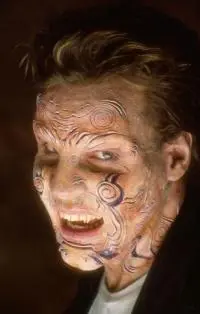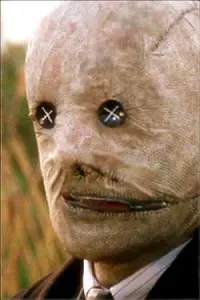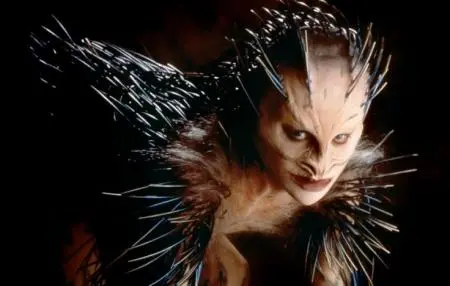Last year, the good folks at Scream! Factory, the horror imprint of specialty Blu-Ray manufacturers Shout! Factory, released something truly special: the director's cut of Clive Barker's cult classic Nightbreed. Fans of the film, as well as Barker himself, had been eager to see the version of the film its creator had originally intended to release back in 1990. The studio behind the picture, Morgan Creek, had unfortunate misgivings and short-sightedness about Nightbreed, and as a result, recut it to remove much of the emotional and psychological elements, mis-marketed it and gave the film a microscopic release, ensuring its failure at the box office (you can read the full details of the film's production history/woes over at Clive Barker's website).
Even in its truncated form, the film enjoyed cult status on VHS and cable, quickly becoming a favorite for its positive depictions of monsters, freaks and weirdos, who are pitted against the brutal stupidity of police, religious leaders and mind doctors. Combine this narrative with some spectacular make-up effects and set design, a thoroughly creepy performance from filmmaker David Cronenberg as the unbalanced psychiatrist Decker, and one of Danny Elfman's best scores (which you can stream for free here), and you begin to understand the beguiling charm of Nightbreed.
And now, thanks to Scream! Factory, which has also made the film available for streaming on Netflix and the newly announced Shudder, old Nightbreeders can see the film as it was originally intended, and new fans can experience a truly original, intense, and altogether wonderful cinematic experience.
But what about Cabal, the 1988 novel by Barker that spawned Nightbreed? Is it as deserving of the praise and fandom showered upon its cinematic counterpart? Put another way, should fans of the movie pick up the book? Conversely, if there are those out there who have read the book but not seen the film, are they missing out on anything?
These are both interesting and complicated questions, primarily because Barker more or less conceived of the book and the film simultaneously. From a 1990 Fangoria Magazine interview (reprinted at Barker's website, a fantastic resource featuring all kinds of information on the book and film, including the auteur's original sketches of numerous Breed characters) he states:
I realized that it would lend itself very nicely to [a] movie adaptation: it was economic in terms of narrative structure and I thought it might be something I'd want to do myself.
Because of this, I personally feel Cabal almost stands as the first draft of what would ultimately become Nightbreed. The film is the polished, final version of the narrative which began life in prose form.
There are two qualities that best represent this dynamic between book and film: character motivation and imagination. Let's dive right in with the first quality so as to better understand why Nightbreed in many ways tops its literary Doppelganger.
(NOTE: This column only references the director's cut of Nightbreed and ignores the original theatrical version.)
(FURTHER NOTE: SPOILERS abound ahead.)
Character Motivation
 Boone
Boone
The protagonist of this narrative, Boone, is basically the same between Cabal and Nightbreed—he's a leather jacket-wearing miscreant of sorts, misunderstood and plagued by dark and violent visions. The core difference between Boone in Cabal and Boone in Nightbreed is this: in the former, his visions do not include Midian, the place below the cemetery in rural Canada where the outcast and persecuted "monsters" live, the home for people with no home, no place to belong, a place that forgives earthly transgressions.
The inciting incident of both book and film narratives revolve around Boone being accused of heinous crimes by his psychiatrist Dr. Philip Decker, who we quickly learn is the real killer, pinning his ghastly deeds on our troubled protagonist. Not able to fully trust his own mind and actions, and harboring an implicit trust of the "good doctor," Boone all-too-quickly accepts guilt. Decker gives him a bottle of pills, ensuring him they will control his violent impulses and help his addled head (they're actually hallucinogens), and tells Boone he has twenty-four hours to turn himself over to the police.
Stoned out of his gourd and carrying the burden of murders he did not commit, Boone attempts suicide by stepping in front of a semi-truck. But this only manages to land him in the hospital with minor injuries (the truck only knocks him around a little). In his room, he meets a man named Narcisse, who not only knows about Midian, but also how to get there. Barker writes in Cabal:
He'd heard the name of that place spoken maybe half a dozen times by people he'd met on the way through, usually those whose strength was all burned up. When they called on Midian it was as a place of refuge, a place to be carried away to. And more: a place where whatever sins they'd committed—real or imagined—would be forgiven them. Boone didn't know the origins of this mythology nor had he ever been interested enough to inquire. He had not been in need of forgiveness, or so he thought. Now he knew better.
And with this, Boone decides he MUST travel to this fabled refuge, casting him more as a victim of circumstance rather than a hero with a purpose in life, which is what Boone ultimately becomes. In traveling to Midian, his presence and his actions directly lead to human or "natural" knowledge of its whereabouts, and thus to the haven's total destruction by the hands of ignorant, intolerant, God-fearing, gun-toting thrill-killers, among them most of a small town's police force. Baphomet, the God of the Nightbreed, who made Midian, charges Boone with leading his people and establishing a new refuge for the outcasts of society.
This call to action by a higher power becomes less a product of chance, and more the inevitable outcome of fate in the film. Within Midian's many catacombs, there is drawn a prophecy, absent from the book, that predicts Boone's arrival, destruction of and charge to rebuild Midian. Moreover, Boone's dark visions prior to learning of Midian's actual existence involve glimpses of the haven's inhabitants, and he is obsessed with the mythology of the place (unlike his literary counterpart), giving Boone his heroism via predestination, rather than by default of his conditions. Thus, in Nightbreed, Boone has a specific drive to fulfill his destiny by arriving at the enticing place once thought to be mere delusion and accepting the task of leading his people through a love and admiration for them that predates his meeting them in person. And this ultimately makes for a more compelling narrative and character arc, a deeper reason to invest our time and our empathy.
Lori and Decker
Boone is not the only character with more satisfactory motivations and objectives in the film. Lori, Boone's girlfriend, goes through a journey of self-discovery in both Cabal and Nightbreed, changing from a "normal" or "natural," who fears the citizens of Midian and the evil they supposedly represent, to a woman who wants to join the Breed, because she finds pleasure and excitement in the dark side. Now, in Barker's novel, this desire is indeed more pointed than in his film, which portrays Lori more as a "stand by your man" or "true love lasts forever" kind of gal, who wants to become Nightbreed simply because Boone is their leader now, and she doesn't want to be without him. This facet of Lori's desire is present in Cabal as well, but it is ultimately more believable in the film, since the relationship between Lori and Boone is portrayed in the novel as icy, passionless and pretty much void of sex. It is hard to accept Lori's undying devotion to a man who has given her no real reason to warrant such devotion. Contrast this with Nightbreed, where Boone and Lori can't keep their hands off each other and display genuine affection before the inciting incident, and whose passion for one another only intensifies once the allure of Midian and the Nightbreed are fully revealed.
Even our antagonist, the demented, burlap mask-wearing doctor Decker, has a more compelling on-screen drive behind his actions. Cabal's Decker merely needs a scapegoat to blame for his crimes, so that he can reinvent himself in a new city and start his killing over again, whereas in his Nightbreed incarnation, he has dedicated his life to eradicating the "filth" of the world, viewing the inhabitants of Midian as the pinnacle of his genocide. His relentless pursuit of Boone is less about preserving his fall guy, and more about using our hero as a means of discovering the location of his greatest enemies.
In all three examples, the cinematic versions of Boone, Lori and Decker display far more complex and layered motivations driving their actions than their literary counterparts, thus offering viewers more solid foundations for investment in these characters.
Imagination
Not only are character motivations more polished and the narrative made tighter by cinematic economy, Barker's imagination is allowed to fully blossom on the screen. He states many times that his characters in the novel are drawn "impressionistically," giving scant detail of how the Breed looks and interacts. In prose this is perfectly acceptable, because it allows the readers to invent much of the visuals themselves. The problem with this, of course, is that much of what makes Barker such an iconic figure in the world of horror is his immense and truly unique imagination, which we unfortunately only see in sketches on the page, but which becomes a fully realized vision on the screen.
Even the author acknowledges the visual richness of the film compared to his novel. From the aforementioned Fangoria interview, reprinted on Barker's website:
One of the things I love about making a movie from something I've written is the pleasure of being able to reinvent your imagination: you've done it once, you know the way it looked when you wrote it, and then you reinvent it entirely. Nightbreed doesn't look the way I imagined it when I was writing Cabal. It has turned out to be much larger in scale than I originally anticipated....
Barker goes on to say:
I think this movie will be a kind of ride...sort of a ride through the space between my ears, a trip through Clive Barker's skull...I hope it will be the kind of dream you don't want to wake up from, the kind of dream that when you've opened your eyes you think, 'I wouldn't mind going back there.'
To demonstrate this divide between impressionistic characters in the novel who come to life—one might even say literally—on the screen, consider that the porcupine woman Shuna Sassi (pictured above) does not appear in Cabal. Also note the character Peloquin, described in the book as a kind of lizard man, becomes something wholly unrecognizable and original on the screen:
Still, there are those impressionistic descriptions that win out over the effects created by Bob Keen and Image Animation for Nightbreed, particularly Barker's depiction of Baphomet, who made Midian. The God looks like this in the film:
Whereas in Cabal, Barker comes up with something far more fantastic, but ultimately unfilmable (at least by early 90s standards—but PLEASE do not remake Nightbreed):
Her gaze went with her, into a room with walls of frozen earth, and a floor the same, the latter split form corner to corner, and a fissure opened in it from which a flame column rose four or five times the size of a man...its innards churned upon themselves, turning over and over...There was a body in the fire, hacked limb from limb, human enough that she recognized it as flesh, but no more than that...the creature there—not dead, but alive, not Midian's subject, but its creator—rolled its head over in the turmoil of flame and looked her way.
This was Baphomet. This diced and divided thing. Seeing its face, she screamed. No story or movie screen, no desolation, no bliss, had prepared her for the maker of Midian.
Book Vs. Film
We now go back now to the initial questions:
Should those who've only read the book see the movie? Absolutely, yes.
Should fans of the film read the book? Personally, I feel there is no harm in reading ANY book, so yes, of course you should read the book. Particularly if you are a fan of the film, because while there are numerous differences between the characters and what drives them to action, it does shed some light on aspects of the characters that are hard to capture on screen, particularly where Lori is concerned. Moreover, Barker depicts certain characters in ways that were unfilmmable at the time, creating, if you will, an alternate universe version of the same narrative, existing side by side with its motion picture counterpart. Yes, the book has its rough spots, and yes, Barker improved upon them with his film, but I still found the novel highly enjoyable and, just as with the cinematic ride through Barker's skull, one I wouldn't mind revisiting.
What say you, LitReactor community? Have you seen Nightbreed and/or read Cabal? Which do you prefer, or do you like them both? Let us know what you think in the comments section below.

About the author
Christopher Shultz writes plays and fiction. His works have appeared at The Inkwell Theatre's Playwrights' Night, and in Pseudopod, Unnerving Magazine, Apex Magazine, freeze frame flash fiction and Grievous Angel, among other places. He has also contributed columns on books and film at LitReactor, The Cinematropolis, and Tor.com. Christopher currently lives in Oklahoma City. More info at christophershultz.com












